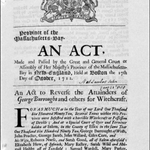
A group of 8th graders from North Andover Middle School in North Andover, Massachusetts are championing efforts to posthumously pardon a young woman who was sentenced to death for witchcraft in 1693 during the height of the Salem witchcraft hysteria.
The students in Carrie LaPierre’s civics class spent a year researching the case of Elizabeth Johnson Jr., who they discovered was the only remaining person wrongfully convicted of witchcraft in the colony who had not been exonerated. They reviewed original historical sources, learning that Johnson was targeted because she belonged to a politically disfavored family, deviated from accepted gender norms, and may have been intellectually disabled.
After gathering their research, the students began a letter-writing campaign to clear Johnson’s name and persuaded their state senator, Diana DiZoglio (pictured) to introduce legislation to exonerate Johnson. The students helped draft the bill, which DiZoglio introduced in March 2021 and which received a hearing in the Senate Judiciary Committee on July 27.
Twenty-eight members of Johnson’s family were persecuted on superstition-backed claims of witchcraft. She was unmarried, and was described by contemporaries as “simplish at the best,” “senseless,” and “ignorant.” After confessing to being a witch, she was sentenced to be hanged, but received a reprieve and was never executed. Johnson was 22 years old at the time of her trial and lived into her 70s. “[B]ecause Elizabeth was not hanged for her alleged crime, she was overlooked.” DiZoglio said in written testimony submitted to the Senate committee. “Because she never had children, there is no group of descendants acting on her behalf.”
“It is important that we work to correct history,” she said. “We will never be able to change what happened to these victims, but at the very least, we can set the record straight.”
“Part of our introduction to the civics class overall is based on the idea of identity, values, stereotypes and civil discourse,” LaPierre told the international news service Agence France Press. “[T]he kids’ efforts righted a long-standing wrong, and I want them to be proud of that.”

Exonerating Wrongfully Accused ‘Witches’
There have been multiple efforts to posthumously pardon those wrongfully convicted of witchcraft in the Salem hysteria. However, Johnson’s case was overlooked or remained undetected on each occasion.
In 1711, the colonial legislature reversed 22 of the convictions, acting on petitions from some of the accused and the children of those who were executed (see image, right). After Arthur Miller’s play, The Crucible, drew attention to the witch trials as an allegory for the political witch hunts of the 1950s, Massachusetts enacted legislation in 1957 to exonerate more of the accused. The legislature passed another bill in 2001 to exonerate the falsely accused, but again failed to identify Johnson’s case.
DiZoglio said the students’ research had determined that Johnson is the only person condemned for witchcraft at the time who has yet to be formally pardoned.
The History of Witchcraft Executions in the U.S.
According to the Espy file of historic executions in the United States, 26 women and 9 men were executed for witchcraft in U.S. colonies or territories. The outcomes of the trials were largely preordained. Those who asserted their innocence were condemned; those who falsely confessed were spared execution.
Nearly all the witchcraft executions took place in Puritan New England. In the years 1647 through 1662, Connecticut hanged seven people falsely accused of witchcraft. Most of the witchcraft executions were in neighboring Massachusetts, where, beginning in 1648, 26 were executed. The witchcraft killings culminated in 1692, when false charges of witchcraft claimed 20 innocent victims. The Espy file reports one colonial-era witchcraft execution outside of New England: Rebecca Fowler was executed in Maryland in 1685. The last witchcraft execution occurred nearly a century later, when an enslaved Black man named Manuel was burned at the stake on witchcraft charges in Illinois in 1779.
The witchcraft executions are regarded as an illustration of how capital punishment has been applied to harshly punish women from disfavored groups or whose lifestyles or beliefs deviate from socially dominant norms. In capital cases, UN Special Rapporteur on Extrajudicial, Summary, or Arbitrary Executions Agnes Callamard said in 2018, “courts judge women not just for their alleged offenses, but also for what are perceived to be their moral failings as women.”
Woman account for approximately 2% of all people sentenced to death in the United States since colonial times but comprised three-quarters of those executed for witchcraft. In discussing the effort to posthumously pardon Johnson, Jane Swift — who issued the pardons in 2001 and is the only woman to serve as Governor of Massachusetts — said, “What has always resonated with me is that these are some of the earliest historical examples in the U.S. of women being vilified for acting outside of their accepted role.”
Andrew Brinker, Three centuries later, a push to exonerate one last witch, Boston Globe, August 18, 2021; Katie Lannan, Lawmakers asked to clear one more name from Salem witch trials, State House News Service, July 29, 2021; William J. Kole, 8th-graders lead effort to pardon wrongly convicted ‘witch’, Associated Press, August 19, 2021; Neil Vigdor, She Was Declared a Witch at Salem. These Middle Schoolers Want to Clear Her Name, New York Times, August 20, 2021; Thomas F. Harrison, Tabula rasa: Massachusetts lawmakers summon clean slate for state’s last convicted witch, Courthouse News Service, August 23, 2021; Salem ‘witch’ to be pardoned thanks to US teens, Agence France Presse, August 24, 2021.


